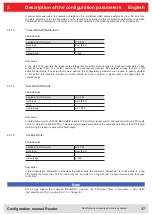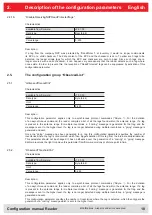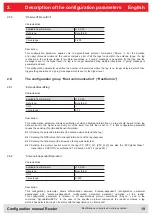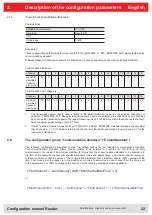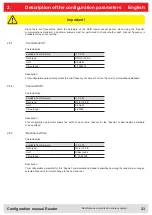
Configuration manual Reader
14
Modifications, misprints and errors excepted.
English
2.
Description of the configuration parameters
2.4.7.
“IntelligentWrite”
Characteristics:
available from firmware:
v1.30.00
Data type:
Bool (8-bit)
Unit:
–
Value range:
0; 255
Description:
Depending on the type of tag, it requires 10 to 20 milliseconds time to write 16 bits of data (one word). If for instance
a 96-bit EPC should be written, then the time which a tag requires for saving the data is 120 milliseconds in the
worst case. Only a fifth to a tenth of this time would be required for reading the data from a tag. In practice it often
happens that the data written to a tag were already present on it. Despite this, the tag requires the full stated time
to complete the write command. This configuration parameter should be activated in order to accelerate the write
event and to avoid writing data when they are already present on the tag. To achieve this, before writing to the tag
the reader first reads the relevant data area on the tag. It then writes only those parts which it is necessary to change.
Note: If a memory area on a tag is protected by a “Lock” against overwriting, and if identical content is scheduled
to be written to the tag with “IntelligentWrite” activated, no error message is generated by the reader. No write
command is issued to the tag in the process of reading the existing data, comparing it with the data to be written
and establishing by the reader that no changed data need be written to the tag. With no write command issued,
the reader is not in the position to detect the “Lock” on the memory area.
2.4.8.
“VerifyWrite”
Characteristics:
available from firmware:
v1.30.00
Data type:
Bool (8-bit)
Unit:
–
Value range:
0; 255
Description:
After a write operation, a tag sends the result to the reader. This result can be either an error code or a success
message. The memory cells of a tag cannot be written infinitely many times, since they are subject to ageing.
Depending on the tag, it has a working life of 1,000 to 1,000,000 write cycles. At the end of a tag's working life it
can occur that following a write operation a tag sends out a success message to the reader, but has not stored
the data correctly in the tag memory. If “VerifyWrite” is activated, the reader issues a read command after receiving
the success message. This reads the data in the tag memory and reports any mismatches to the higher level
as “Verify Fail”.
Important!
Even with “VerifyWrite” activated, there is no guarantee that the data are stored correctly in the tag memory.
Aged tags may “forget” the content of their memory, be it minutes or hours after the write operation!

















